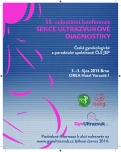The alarming incidence of gestational diabetes mellitus using currently used and new international diagnostic criteria
Authors:
Kateřina Anderlová 1,2
; Hana Krejčí 1,2
; P. Klusáčková 1; M. Moravcová 2; H. Benáková 3; Vratislav Krejčí 2
; A. Pažízek 2; M. Haluzík 1
Authors‘ workplace:
III. interní klinika 1. LF UK a VFN, Praha, přednosta prof. MUDr. Š. Svačina, DrSc., MBA
1; Gynekologicko-porodnická klinika 1. LF UK a VFN, Praha, přednosta prof. MUDr. A. Martan, DrSc.
2; Ústav lékařské biochemie a laboratorní diagnostiky 1. LF UK a VFN, Praha, přednosta prof. MUDr. T. Zima, DrSc., MBA
3
Published in:
Ceska Gynekol 2014; 79(3): 213-218
Overview
Objective:
The aim of our study was to analyze the results of oral glucose tolerant test (oGTT) of pregnant woman with currently used Czech criteria for diagnosis of GDM, to find out the prevalence of GDM if the measurement of glycemia in 1 hour of oGTT is included and to compare the prevalence of GDM using the new IADPSG (International Association of Diabetes and Pregnancy Study Groups) criteria versus the currently used Czech criteria.
Design:
Retrospective analysis.
Settings:
Department of Obstetrics and Gynecology of the First Faculty of Medicine and General Teaching Hospital, Prague.
Methods:
Data from the standard 75g 2-hour oral glucose tolerance test (oGTT) of 2567 pregnant females were analyzed using the currently recommended Czech cut-off values for plasma glucose at baseline and at2 hours of oGTT (5.6 and 7.7 mmol/l) and at baseline, 1 and2 hours oGTT (5.6, 8.9 and 7.7 mmol/l). The frequency of GDM using the Czech criteria was compared with the frequency of GDM using the novel IADPSG criteria (5.1, 10.0 and 8.5 mmol/l). Statistical analysis was done using the software GNU PSPP Statistical Analysis Software version 0.8.0-g0ad9f6.
Results:
When using the current Czech criteria (at baseline and 2 hours of oGTT) GDM was diagnosed in 362 (14.11%) females. Inclusion of glycemia at 1 hour of oGTT increased the frequency of GDM to 571 (22.26%) females (p<0.00). With the novel IADPSG criteria GDM was diagnosed in 818 (31.89%) females (p=0.038). 503 females i.e. 19.61% and 394 females i.e. 15.36% (when glycemia at 1 h of oGTT included) respectively met the IADPSG but not the Czech criteria and thus were not treated for GDM. In contrast, 47 (1.83%) resp. 147 (5.73%) of tested women who met the Czech but not the IADPSG criteria received unnecessary diabetes treatment.
Conclusion:
The frequency of GDM is higher with the novel IADPSG criteria when compared with the currently used Czech recommendation. Switching to IADPSG criteria might help unravel hitherto unidentified cases of GDM and thus improve outcomes for females with GDM and their offsprings.
Keywords:
gestational diabetes, oral glucose tolerant test, oGTT, Hyperglycemia and Adverse Pregnancy Outcomes (HAPO) study
Sources
1. Andělová, K. Doporučený postup provádění screeningu poruch glukózové tolerance v graviditě. Čes Gynek, 2009, 74, S1, s. 7.
2. Česká diabetologická společnost. Diabetes mellitus – laboratorní diagnostika a sledování stavu pacientů. DMEV, 2012, 1, s. 51–58.
3. Česká diabetologická společnost. Standardy péče o diabetes mellitus v těhotenství. DMEV, 2007, 4, s. 229–231.
4. Franeková, J., Jabor, A. Gestační diabetes mellitus: analýza 2043 výsledků oGTT – je čas na změnu? Klin Biochem Metab, 2010, 18(39), s. 30–37.
5. Hillier, TA., Pedula, KL., Schmidt, MM. Childhood obesity and metabolic imprinting. Diabetes Care, 2007, 30 (9), p. 2287–2292.
6. International Association of Diabetes and Pregnancy Study Groups Recommendations on the Diagnosis and Classification of Hyperglycemia in Pregnancy. Diabetes Care, 2010, 33, 3, p. 676–682.
7. King, HM., Rewers, M. Global estimates for prevalence of diabetes mellitus and impaired glucose tolerance in adults. Diabetes Care 1993, 16, p. 157–177.
8. Krejčí, H. Gestační diabetes mellitus. Postrgrad Med, 2012, 14, příloha č. 3, s. 49–54.
9. Landon, MB., Mele, L., et al. The relationship between maternal glycemia and perinatal outcome. Obstet Gynecol, 2011, 117, p. 218–224.
10. Owen, LA., O´Sullivan, EP., et al. ATLANTIC DIP: the impact of obesity on pregnancy outcome in glucose-tolerant women. Diabetes Care 2010, 33, p. 577–579.
11. Pelikánová, T., Bartoš, V., et al. Praktická diabetologie. Praha: Maxdorf, 2011, 742 s.
12. The HAPO Study Cooperative Research Group. Hyperglycemia and adverse pregnancy outcomes. N Engl J Med, 2008, 358, p. 1991–2002.
13. Vohr, BR., Boney, CM. Gestational diabetes: the forerunner for the development of maternal and childhood obesity and metabolic syndrome? J Matern Fetal Neonatal Med, 21, 2008, 3, p. 149–147.
14. WHO. Summary of technical report and recommendations. Definition and diagnosis of diabetes mellitus and intermediate hyperglycemia: report of a WHO/IDF consultation. WHO, 2006, ISBN 92-4-159493-4.
15. Yogev, Y., Visser, GH. Obesity, gestational diabetes and pregnancy outcome. Semin Fetal Neonatal Med, 14, 2009, 2, p. 77–84.
Labels
Paediatric gynaecology Gynaecology and obstetrics Reproduction medicineArticle was published in
Czech Gynaecology

2014 Issue 3
Most read in this issue
- Diagnostic algorithm in pregnancies of uncertain viability or unknown location – a review of the latest recommendations
- Myo-inositol in the treatment of polycystic ovary syndrome
-
Prenatal diagnosis of skeletal dysplasia in first trimester of pregnancy
X-linked dominant chondrodysplasia punctata - HELLP syndrome complicated by liver rupture – case report
